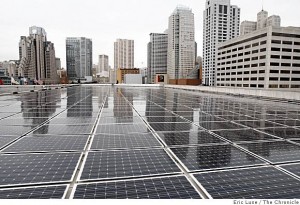Economic woes have challenged California’s commitment to install 1 million solar power systems by 2016, but thanks to continuous advances in solar technology and financing options, as well as a variety of rebate and incentive programs, the state is getting back on track to achieving that goal. In California and across the nation, solar systems have never been more affordable.
Eco-minded Californians are realizing how important it is to assume leadership roles in the state’s quest to reduce carbon emissions, especially when it comes to alternative clean energy.

Case in point: San Francisco realtor Shawn Case. Case is an EcoBroker Certified Realtor for Herth Real Estate, a company based in the San Francisco Castro District that has been in business for 45 years. Herth’s EcoBrokers specialize in finding real estate, home, business and commercial structures that are environmentally friendly.
Case realized that as an EcoBroker, he was a representative of a movement to adopt ecologically sound practices, products and technology, yet his own home was still powered by energy generated by fossil fuel. It was time to step up and go solar. Case got his roommate on board and together they contacted Energy Efficiency Solar, a company recently acquired by Acro Energy Technologies.
Now that the system is installed, their energy bills have dropped dramatically. With conventional electricity, the home consumed about 500 to 1,300 kilowatt-hours each month, adding up to $70 to $350 on electrical bills each month. The monthly electric bill now? Zero.
Case is saving money on his gas bill, too. Since the home now produces more electricity than it consumes, Case has turned to electrical space heaters to keep individual rooms warm, rather than relying on gas to heat the entire home. His annual utility bill has dropped from $3,000 per year to $500 for electricity and gas combined. His upfront solar costs are more than worth it.
Plus, Case is now earning income from his residential solar panel system, selling excess energy back into the grid. Like most states, California utilities are required to invest in clean energy. The utilities are allowed to partially meet that mandate by purchasing power generated by residential solar systems.

How much can you earn from excess solar energy?
In sunny states like California, particularly in Los Angeles and San Francisco, the amount earned from selling power to utilities can be significant. Utilities charge customers different rates throughout any given day — lower rates when the demand for electricity is not great, and higher rates during peak demand periods. Solar panel systems produce electricity most efficiently during the sunniest period of the day, which happens to coincide with peak demand hours.
Case enjoyed deep discounts for his solar power system, made possible through incentives at the federal and California state levels, as well as the local San Francisco level. He qualified for San Francisco’s GreenFinanceSF program, which enabled him to get a loan to pay for the remaining balance.
Case enjoys watching his electrical meter run backwards, too, sending electricity back into the grid. Although he was motivated to go green as an example to potential customers, there’s no doubt that he’s enjoying more green in his pocket as well.

 Follow
Follow